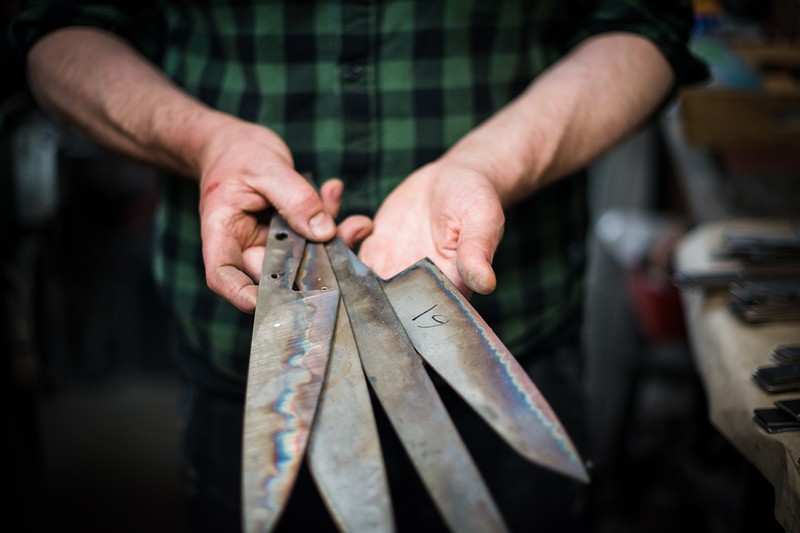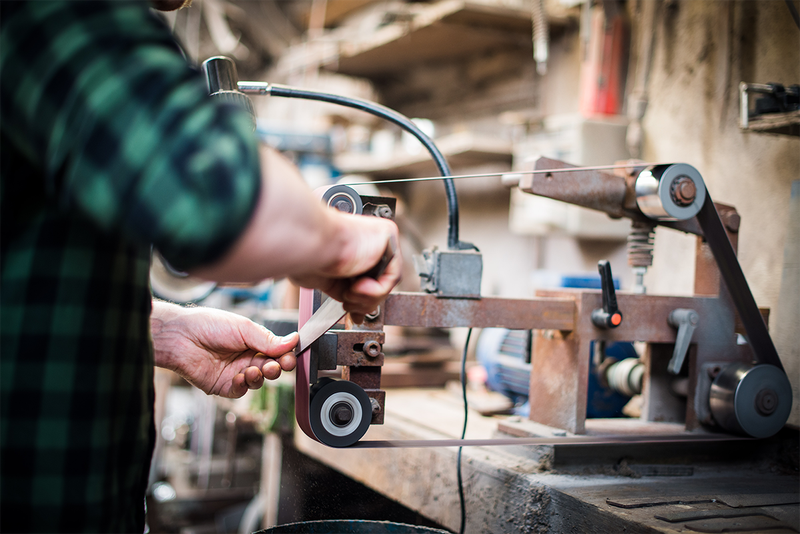Everything You Need To Know About Knives
I first got into knives because I had an uncle who was a collector. He died when I was very young and I inherited all these fantastic and random knives when I was a bit too young – I messed a lot of them up, throwing them around. Becoming a butcher and having a family that was very connected to food, the chef knife was a tool of the trade and I wanted to learn how to sharpen them properly. So I went to a good friend, Rory Conner, for help. Rory is one of Ireland’s original chef knife-makers and he’d trained with a fascinating gentleman called Bob Loveless, who was one of the world's top knife-makers. Bob was the Hunter S. Thompson of the knife world. I really got into knife making because it's a very interesting process: it combines rock ’n’ roll and a bit of gung-ho spark with the absolute finesse and perfection of making something very precise and well balanced. It’s a craft that ticks a lot of creative boxes.
As a business, we’ve been consistently busy from the beginning. I think part of that is because knife-making is the side business. My family makes cheese, I make all the salami and cured meat, and my wife and I have had five kids over the past ten years, so there’s been a number of different things going on. I got into knives because of the food connection and knowing all these chefs. Over the past ten years – because of the Instagram boom – I’ve been getting requests for more knives than I can actually make. It grew to a point in 2017 where I had 980 people on the waiting list, and my wife had to do an incredible amount of work keeping track of all the people who were wondering where their knives were, so we just closed the books. I’ve managed to get the list down to about 400 people. This isn’t something where I can just hire people to bang them out and scale it up, as knife-making for me is about creativity and happiness – and I have enough businesses already. So I’ve gone down the road of just keeping it to scale and ticking people off the list as I get to them. In many ways, I'm blessed there’s a large demand for them, but they’re not something that can be mass-produced – and that’s not something I want to do either.
I'm a very selfish person in the sense that I don’t take bespoke orders. The way I make my knives is that I have a selection of at least 60 knives in stock at once. When somebody from the waiting list gets their turn, they can choose from that. I don't want to be in a position where I'm worried about making something to reach somebody's expectation. And sometimes materials can hard to find, and you find yourself in a rut where you’re making things you don’t want to and start to resent it. I’ve found that my skill levels have increased tremendously from free rein and being able to adapt to change and use new materials. There’s logic here too, as it keeps the prices of the knives down and affordable, and also instant gratification. When somebody sees a knife that they like, they buy on the web store and the next day it arrives via courier.
I've got way too many knives. I once made a set for Francis Mallmann (the Patagonian chef famous for his open-fire cooking) which was 22-knives strong – one for each of the major roles in the kitchen. It was such a fun project and I’m glad I did it, but I don't think your average home cook needs to go down that road. Sometimes, it’s not about having the best, most expensive knife in the world; sometimes it’s the wonderful, old, tatty, banged-up knife that will be your favourite. If you have a love for cooking, I find you have a lot of knives. I don't think you should be limiting yourself or getting into trouble for having too many if it makes you happy.
There are only really two knives you need: a paring knife and a chef knife. Having watched my mother, who is an amazing cook, when I was growing up, I define a paring knife as one you use if you can visualise slicing something in the air away from the chopping board – peeling an apple or preparing an onion or garlic, that kind of thing. For me, a chef knife is very much for all your chopping up and food prep. But it’s all down to personal preference.
I don't think people have to invest in knives at all. You can buy a pen for less than a quid and you can write just as well as you could if you bought a Montblanc. But if you're a writer, or writing is something you love to do, then that Montblanc is almost a symbol. It’s something that brings you pleasure every time you open the page – it gives you that pride and connection. It might be unnecessary, but doesn't it bring you happiness? In the knife world, you don't need to have a very expensive knife unless you're in a very specialised field, such as a noodle-maker in Japan, where having a certain knife makes your life easier. What’s more important usually is to find the knife that suits you – perhaps one that's elegant and easy to use with good edge geometry that suits your type of cooking. Or if you tend to open tins of beans with a knife, and are a little more rough and ready, then you won’t want to use a very expensive, delicate blade. You have to match your style, your role and your connection to food with your knife.


They always say the way to somebody's heart is through the stomach. For some, food can bring such happiness and – like me – they live for the next meal. But the means to get to that stage is to use a knife. It’s the tool of the trade. Spend wisely of course, but if it brings you happiness why not invest in a tool that makes your life easier?
I’m nervous of the expression ‘lasts a lifetime’. Because if people have that expectation, but they are using their knives every day, their knives will suffer wear and tear. I've seen somebody who’s used the same knife every day of their life since culinary school – that large chef knife now looks like a toothpick! With knives, you tend to get what you pay for. A knife that’s made with better steel will be that little bit sharper. A knife that’s got a special ergonomic handle will be more comfortable. Little things make a difference, and good design and good materials are an investment.
There are a few things to consider when it comes to looking after your knives. The materials available nowadays are designed to be incredibly robust. They’re made to survive the constant wetting and drying, the heat and cold, being left on a magnetic rack in direct sunshine or inside the hustle and bustle of a kitchen drawer. And then there are Japanese knives, for example, that can be chipped and damaged so easily, but they are designed to be that way. Regardless of the material, never put knives in a dishwasher – the combination of the water and heat will damage the glues, warp wooden handles and separate the metal blade from the handle. Storage is also important. Throwing knives into drawers with other knives is a bad idea: it’s very hard to scratch a knife, but another knife will scratch a knife. Like everything in life, if you buy something that needs extra care and attention, be aware it will need that care and attention.
I spent many years trying to find the perfect knife steel, and I came to the conclusion that there's no such thing as the best, just the best for a particular job. I have become more of a fan of stainless-steel knives over the years. When it comes to handle material, I still find myself drawn to bog oak. It’s an interesting material and can be stabilised to last a long time. I also think there's something fascinating about the history, and we seem to have such a connection to it in Ireland.
There are lots of devices you can spend large amounts on to sharpen a knife. But in my opinion, sharpening stones are still the best value for money. It's a very simple skill to learn, but it will take some time to develop a routine and also the discipline to put aside the time to do it. Eventually they will give you better results than most machines out there. Sharpening knives can also be very meditative and relaxing. There’s one method for sharpening knives: use a coarse stone to develop a burr (the slight catch you feel as you move your thumb over the edge), then refine that edge with a medium-grit stone, then finally polish the knife with a fine-grit stone. This will give you the best result. If you buy the finest, most delicate stone to give you the finest edge and you only use that stone, you won’t get as good a result. That coarse-medium-fine grit progression is what gives you the fine edge.
Knowing how often to sharpen a knife is like asking how long a piece of string is. There are certain knives that are very hard to sharpen, but will stay sharp for a very long time. Then there are steels out there designed to be very easy to sharpen, but you'll have to sharpen them more regularly. There’s no hard and fast rule, but I do think every knife should be able to cut through a tomato without bursting it.
For more information, check out FingalFergusonKnives.com. To attempt to get your hands on one of his knives, follow him @FingalFerguson, where he occasionally releases new products.
DISCLAIMER: We endeavour to always credit the correct original source of every image we use. If you think a credit may be incorrect, please contact us at [email protected].


